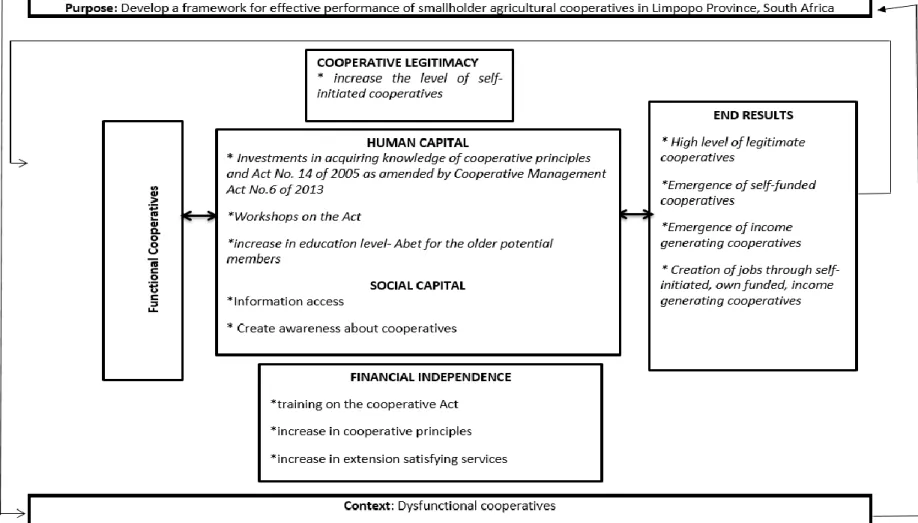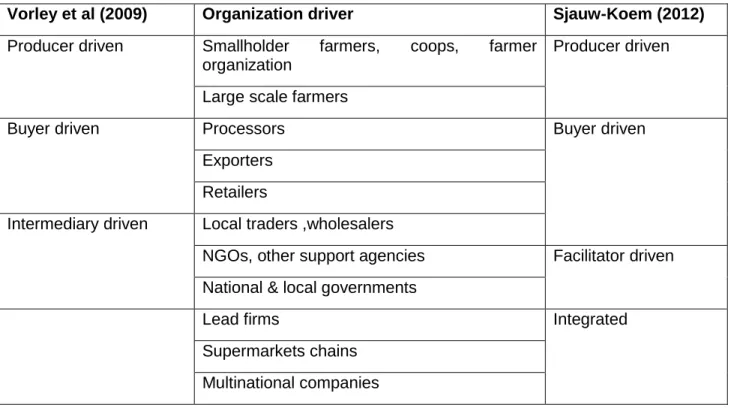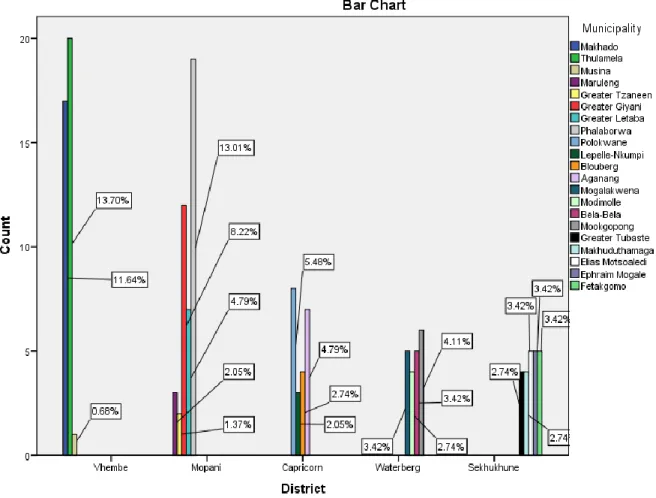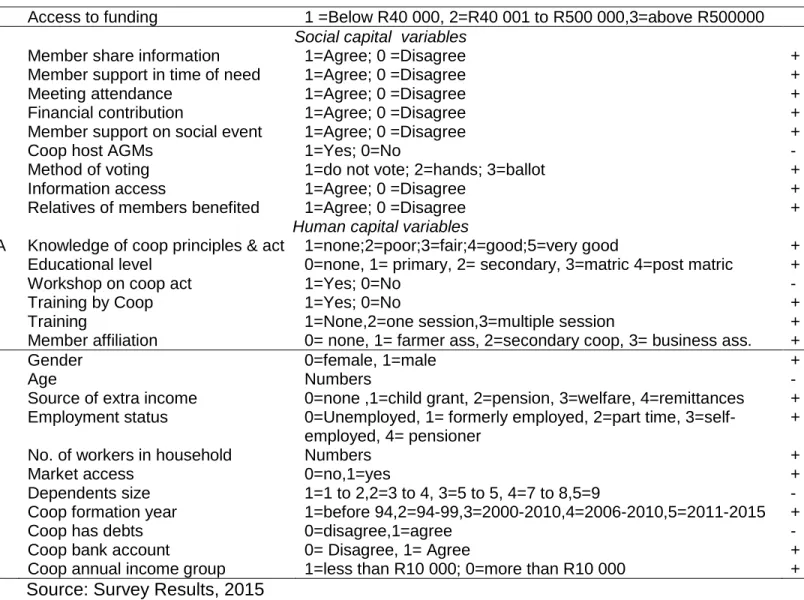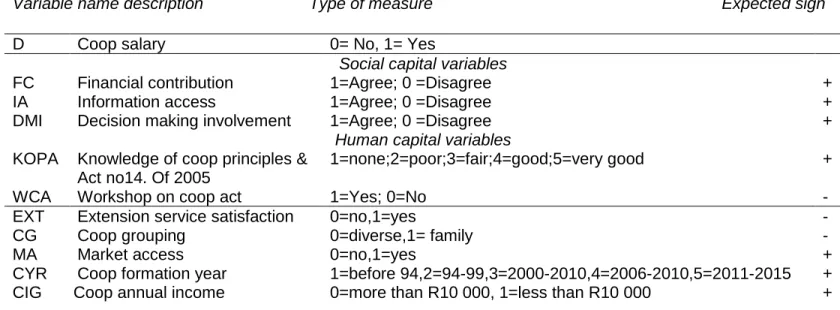The study also assessed the differences that can be used to distinguish between cooperatives that earn a monthly income and those without a monthly income. The main objective of the research was to develop a framework that could be used to create sustainable cooperatives in the Limpopo Province in the future.
- Background
- Problem Statement
- Justification of the Study
- Study Objectives
- Main objective of the study
- Specific Objectives
- Research Questions
- Research Hypothesis
- Limitation and delimitation of the study
- Outline of the study
In the past twenty years of democracy, South Africa has witnessed a massive transformation of the co-operative sector. There is a need to develop a framework that will guide the formation and operational guidelines for smallholder farming cooperatives in South Africa in general and in the Limpopo province in particular.
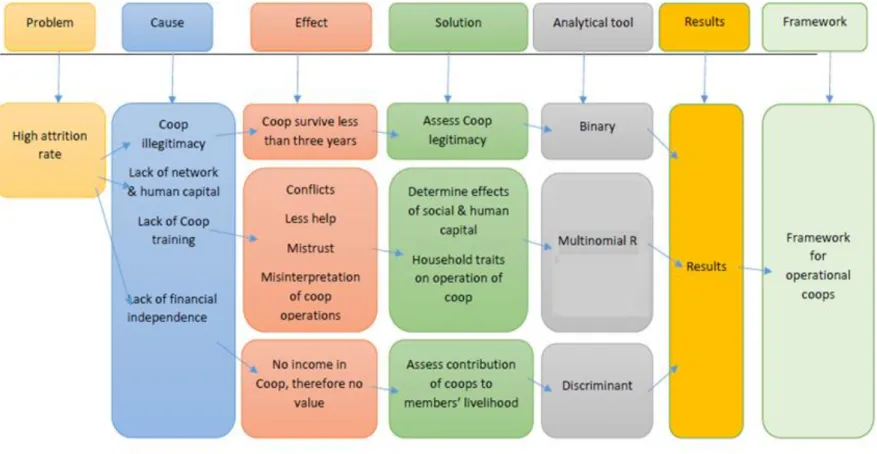
Introduction
General Perspective on Cooperatives
This means that minimizing transaction costs should be one of the cooperatives' goals. It is against this background that Benson (2014) argues that the way in which cooperatives are formed will affect the performance of cooperatives.
Development of operational models
Social capital influence on small-scale agricultural cooperatives
Types: Bonding (between heterogeneous groups), Bridging (between heterogeneous groups) and Linking (between heterogeneous groups) social capital. Farmer participation in small-scale agricultural cooperatives is closely related to human and social capital (Hellin et al., 2009).
Human capital in agricultural cooperatives
Manderson and Kneller (2012) added that organizations with greater human capital intensity have greater opportunities for technological advancement. Falk, 2000) Human capital includes the skills and knowledge acquired during formal and informal learning.
Household characteristics of Agricultural cooperative members
Two-thirds of the membership in registered emerging cooperatives (ie, black-owned, as opposed to established white-owned cooperatives) are women. The decision to assess these variables in the study is based on the idea that the variables will best explain the household characteristics of agricultural cooperatives (Baiyegunhi, 2014).
Contribution of cooperatives to livelihoods
- Roles of Cooperatives in Africa and Globally
- Role of Cooperatives in South Africa
Cooperatives are crucial in the development of the agricultural sector (ICA, 2015 & United Nations (UN), 2015). The pursuit of cooperative development occupies an important place in the CRDP within the context of the government's rural development strategy.
Summary of reviewed literature
Six dimensions of social capital, which were used in this study, were discussed in the review. Issues of mutual trust in the community become vital in the functioning of cooperatives.
Theoretical and Conceptual Framework of the Proposed Study
Therefore, we used social capital indicators to measure social capital. 2012) argue that social capital is an important resource of cooperatives. The study hypothesized that the presence of networks among cooperative members creates better economic performance of cooperatives.
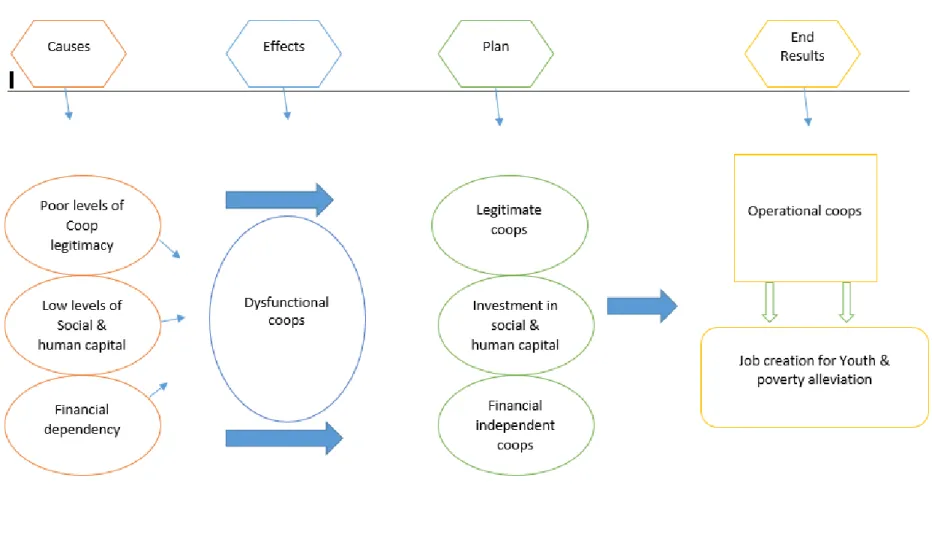
Introduction
- Location of the study area
- Socio economic characteristics of the study area
- Spread of agricultural cooperatives in the study area
- Description of the study area
Limpopo Province is located in the north-eastern corner of South Africa and shares borders with Botswana, Zimbabwe and Mozambique. Limpopo was in third place of the provinces engaged in agriculture in South Africa (16.6%) in 2016.
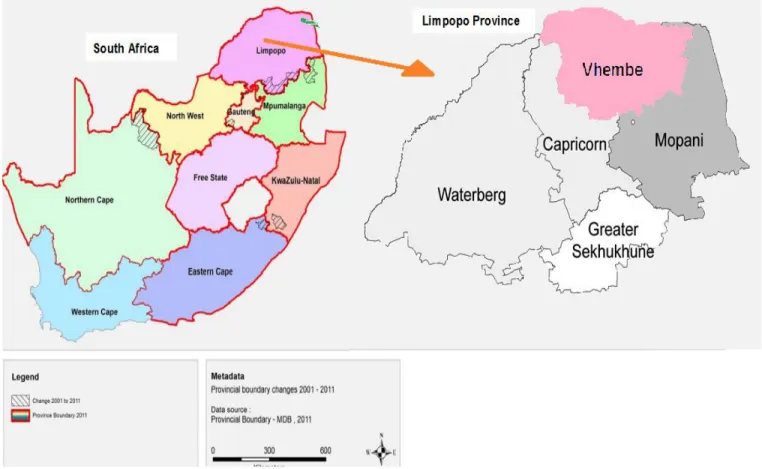
Research Design
- Unit of analysis
- Sampling procedure
- Sample size
- Data collection methods
- Data analysis
The mixed methods approach was adopted because of its ability to gather rich information about the phenomenon under study (Hanson et al., 2005). The quantitative methods in this study measured the relationship between variables, while the qualitative methods explored the experiences and perceptions of respondents. The survey requested permission from the Limpopo Department of Agriculture to facilitate contact with the members of.
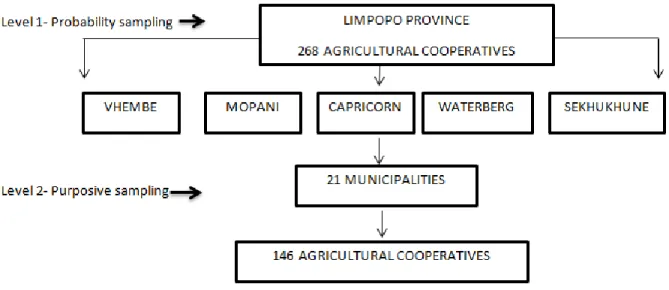
Addressing the study objectives
- To investigate the formation of agricultural cooperatives
- To determine effects of social, human capital variables and household characteristics on
- To assess factors determining the contribution of agricultural cooperatives to livelihoods in
The main sub-objective is the investigation of the effects of social, human capital and households on the economic operation of cooperatives. Social, human capital and household characteristics have a positive influence on the economic performance of cooperatives (measured by access to funding). The first sub-objective was to determine the effect of social, human capital and household characteristics on economic performance of cooperatives.
The Multinomial Logit (MNL) model was used to estimate how social characteristics, human and family capital affect the economic functioning of cooperatives. Discriminant analysis was an appropriate technique to use in this study to identify any significant differences that could be used to separate the two groups (wage earners and non-wage earners from the cooperative). The independent variables are described in Table 3.3.
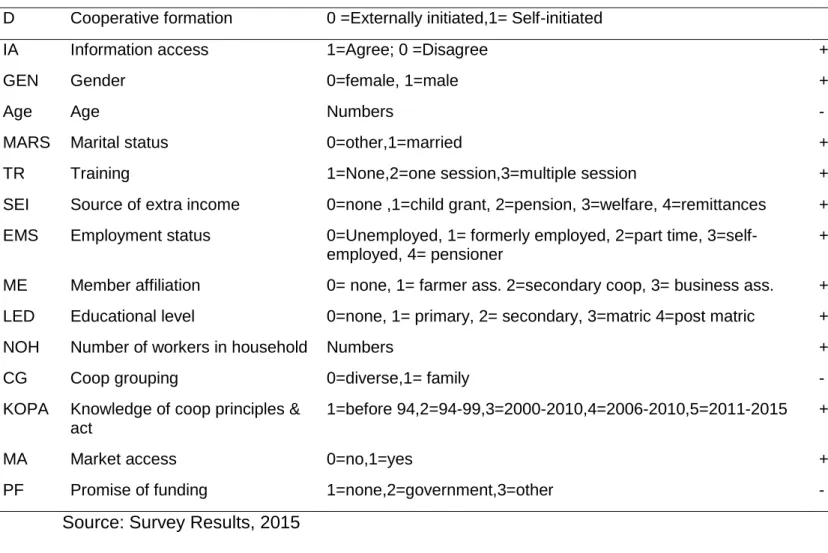
- Introduction
- Presentation of results
- Assessment of the relationship between cooperative formation and socio-economic
- Assessment of the relationship between cooperative formation and socio-economic
- Binary logistic regression model results
- Introduction
- Results from the binary logistic regression model
- Significant variables in the model
- Summary of cooperatives formation determinants
- Discussion of the results
- Discussion of the descriptive results
- Discussion of the significant variables in Binary logistic results
In Table 4.1, cooperative formation was compared with gender, age group and marital status of cooperative leadership in Limpopo Province. The results show that none of the cooperative leaders who had no formal education were in legitimate cooperatives. In this study, if the value of the coefficient value was positive, the implication was, there was an increase in the likelihood that a cooperative interviewee would change to the alternative option from the reference group (in this case, externally initiated cooperatives) or the base group. (in this case, self-initiated cooperatives) (Gujarati, 1992). A negative coefficient value will mean that it would be less likely.
The results showed that the majority of respondents in the sample of cooperatives in Limpopo Province were adults (35 to 65 years) and elderly. The results showed that there were more women in cooperatives than men in the study sample.
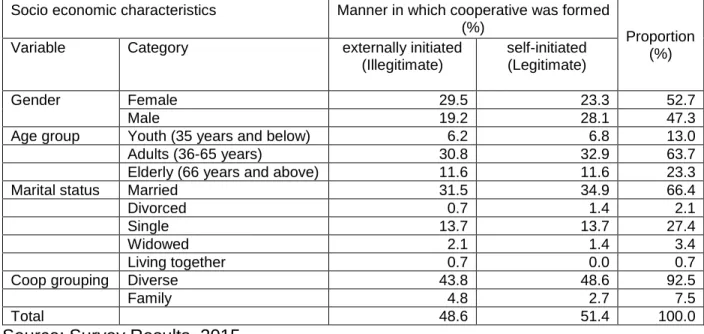
Relationship between access to funding and household characteristics of cooperative in
However, the level of self-financing was more indicative of the low economic participation of members (below R40 000) in the cooperative. Members of cooperatives founded in 2006-2010 mostly received funding in the medium and higher funding categories (15.1% and 8.2%, respectively). Cooperatives run by leaders without an employed member of their family dominated (10.3%) in the medium-funded category (R40 001 to R500 000).
Results indicated that cooperatives led by leaders with more than three workers in their households accessed funding in the middle and higher funded category. Cooperatives led by leaders who depended on pension allowance as a source of extra income were not funded in the higher (above R500 000) funded category.
Relationship between access to funding and human capital variables, market and information
The results suggest that members with stable incomes also had better access to higher funding. The expectation is therefore that members who possess stock of human capital, i.e. those with education, higher level of education, better knowledge of the principles of cooperatives and Act No. 14 of 2005, must be financially independent. For the understanding of the principles and the law is what should lead the members to ultimately form cooperatives in the first place.
If people are in cooperatives and have no knowledge of the principles and actions, that is a mistake. What is worrying in this case is the high proportion of members without any knowledge of cooperative principles and the law.
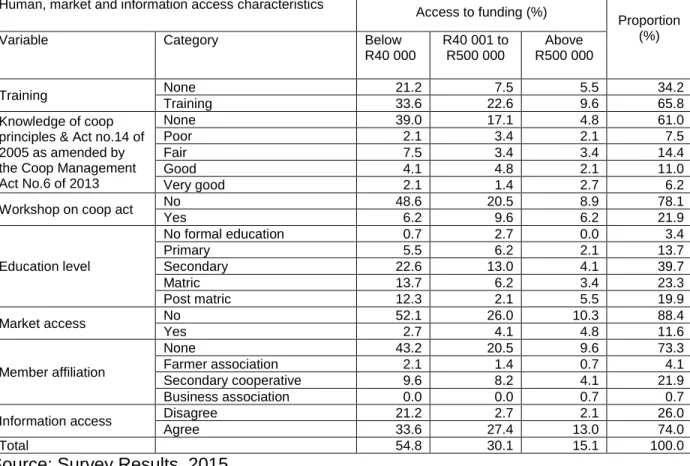
Determinants of access to funding
- Introduction
- Results from the multinomial logistic regression model
- Significant variables in the model
- Variables determining access to funding summarized
In the case of the year of formation of the cooperative and the level of education, it was the opposite. This meant that as the odds of the cooperative's formation year education level increased by 1 unit, there was a progressive decrease in the odds of the current need to have funds. As the odds of market access and dependent size increase by one unit, actual access to finance increases by 16.1 times for market access and 1.8 times for dependent size.
Variables with a negative significant influence in the middle and lower funded category were cooperative founding year and level of education. There were some variables from the regression that were not significant but positive in the middle (R40 001 to R500 000) funded category.
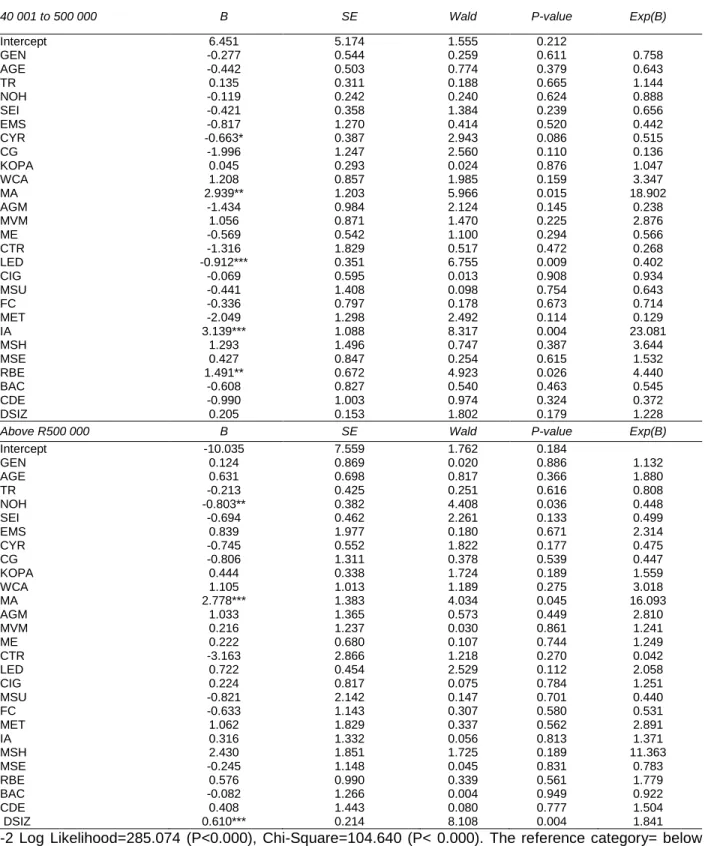
Discussion of the results
- Discussion of the descriptive results
- Discussion of the significant variables in Multinomial logistic regression results
The results indicated that relatives' benefits had a positive influence on access to finance in the middle category. The results also showed that as the level of education increased, access to intermediate financing did not increase. It is less likely by 0.5 times for cooperatives with more years to access.
By increasing access to information, access to medium financing will increase by 23.1 times. Farmers are 4.4 times more likely to have access to medium-term financing.
- Introduction
- Presentation of results household characteristics
- Benefits received from cooperatives
- Discriminant model results
- Introduction
- Results from the Discriminant model
- Significant variables in the model
- Variables that discriminate between cooperatives with income and those without
- Discussion of the results
- Discussion of the descriptive results
- Discussion of the significant variables in Discriminant analysis results
As expected, more than half (4.8%) of the closely related cooperatives received monthly income. The results showed that half (5.5%) of the members with a good knowledge of cooperative principles and law earned a monthly salary. Among those who had a very good understanding of cooperative principles and the Act understood that some (4.1%) of the members earned a salary.
This reflects the fact that knowledge of cooperative principles and law is essential to cooperative income. Only one third (2.7%) of members with poor knowledge of the principles and the Act of the cooperative had.
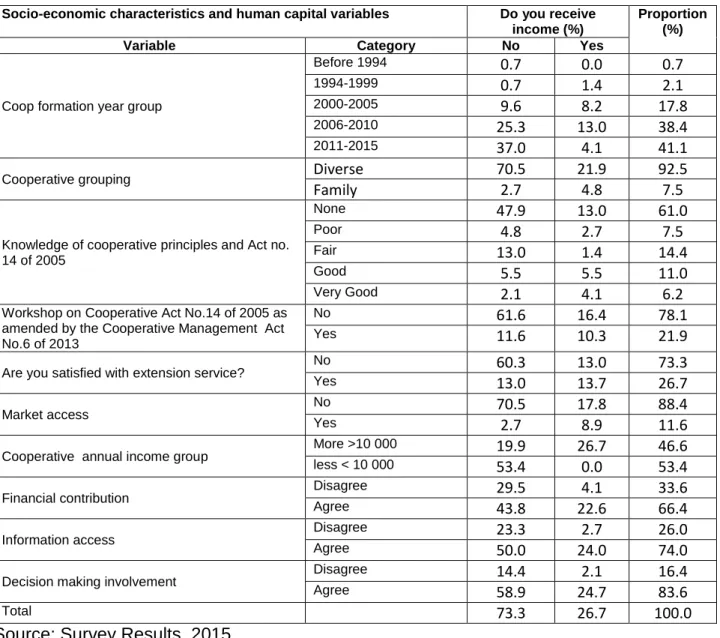
- Introduction
- Summary
- Conclusion
- Recommendations
- Suggestions for future researchers
The results partially support the hypothesis on the basis that two indicators of social capital (i.e. the presence of perceived benefits of members' relatives and access to information) increased the need for access to finance. Those who received monthly income were characterized by members with knowledge of the principles and the Cooperative Act No. 14 of 2005 amended by the Cooperative Act No. 6 of 2013, having. The implication is that if cooperatives receive an increase in human capital (i.e. knowledge of cooperative principles based on Cooperative Act No. 14 of 2005, amended by Cooperative Act No. 6 of 2013, level of education, skills.
The results revealed that members of the cooperatives who earned an income from their cooperatives were associated with having been trained in special cooperative principles and Cooperative Act No. 14 of 2005 as amended by Cooperative Act No. 6 of 2013. The challenge with cooperatives is that if extension workers do not understand the cooperative principles and the Cooperative Act No. 14 of 2005 as amended by the Cooperative Act No. 6 of 2013, their opportunities to be helped are reduced.
Investments in cooperative development of tailor-made extension programs will benefit cooperatives in the long run. We have chosen your cooperative as one of the cooperatives with which we will survey in the province. I am a PhD student at the University of Venda in the Faculty of Agriculture in the Department of Agricultural Economics and Agribusiness, I am currently doing a study entitled: Topic: Towards a Framework for the Effective Operation of Small Agricultural Cooperatives in Limpopo Province, South Africa.
The relationship between member trust and participation in cooperative governance: The role of organizational commitment. An entrepreneur's social capital and performance: The role of access to information in the Argentinian case. Members' perceptions of their participation in cooperative governance: Key to trust and commitment in small-scale agricultural cooperatives.
Members' perception of their participation in the management of cooperatives: The key to trust and commitment in small-scale agricultural cooperatives.
